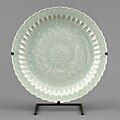

The Musée Cernuschi (French pronunciation: [myze tʃɛʁnuski]; 'Cernuschi Museum'), officially also the Musée des arts de l'Asie de la Ville de Paris ('Asian Arts Museum of the City of Paris'), is an Asian art museum located at 7 avenue Vélasquez, near Parc Monceau, in Paris, France. Its Asian art collection is second in Paris only to that of the Musée Guimet.
The nearest Paris Métro stops to the museum are Villiers or Monceau on Line 2.
History
The museum was founded in 1898 by Henri Cernuschi (1821–1896) in the mansion that used to be his home. It describes itself as the second-oldest Asian art museum in France, and the fifth-oldest Chinese art museum in Europe.
Following a major renovation project from 2001 to 2005, during which the museum was closed, its total exhibition space reached 3,200 m. Another renovation was conducted in 2019–2020.
On 2013/0101, the Cernuschi Museum became part of the public institution Paris Musées, together with 13 other museums belonging to the City of Paris.
Collections
Over the years, the museum's collection has gradually grown from nearly 5,000 objects initially to about 15,000 as of 2021. Originally its collections were overwhelmingly of objects from China and Japan, which have been complemented more recently by artefacts from Korea and Vietnam. Some 900 objects are on permanent exhibition. Most prominent is the large Buddha of Meguro, a Japanese bronze from the 18th century, from the original collection of Henri Cernuschi. Other permanent exhibits include:
- a fine collection of archaic bronze pieces (15th to 3rd centuries BCE)
- Han dynasty objects (206 BCE – 220 CE)
- Funerary statues from the Northern Wei dynasty (386–534 CE) and Sui dynasty (581–618 CE)
- Tang dynasty statues (618–907 CE)
- Ceramics from the Tang and Song dynasties (6th through 13th centuries CE)
- funerary masks in gilded bronze dating from the Liao dynasty (907–1125)
Collection highlights
China
-
 Jade disc. Shandong, 2100–1700 BCE
Jade disc. Shandong, 2100–1700 BCE
-
 Zun vessel, Shang dynasty, 12th century BCE
Zun vessel, Shang dynasty, 12th century BCE
-
 Bird-shaped jade, 11th century BCE
Bird-shaped jade, 11th century BCE
-
 You vessel in shape of a tiger, Shang dynasty, 1100–1050 BCE
You vessel in shape of a tiger, Shang dynasty, 1100–1050 BCE
-
 Two chariot elements, Western Zhou, 1050–771 BCE
Two chariot elements, Western Zhou, 1050–771 BCE
-
 Ding vessel, 900–850 BCE
Ding vessel, 900–850 BCE
-
 Figurine of a Lady, Western Han, 206 BCE – 9 CE
Figurine of a Lady, Western Han, 206 BCE – 9 CE
-
 Bear, Han dynasty, 206 BCE – 220 CE
Bear, Han dynasty, 206 BCE – 220 CE
-
 Heavenly Musician, Northern Wei, 386–534
Heavenly Musician, Northern Wei, 386–534
-
 Barbarian with a horn, Tang dynasty, 625–675
Barbarian with a horn, Tang dynasty, 625–675
-
 Cavalry musicians, Tang dynasty, 618–907
Cavalry musicians, Tang dynasty, 618–907
-
 Female funerary mask, Liao dynasty, 907–1125
Female funerary mask, Liao dynasty, 907–1125
-
 Ceramic pillow, Jin dynasty, 1115–1234
Ceramic pillow, Jin dynasty, 1115–1234
-
 Platter, Qingbai ware, Southern Song dynasty, 1127–1279
Platter, Qingbai ware, Southern Song dynasty, 1127–1279
-
 Bowl, Jun ware, 14th century
Bowl, Jun ware, 14th century
-
 Bronze statue of Bodhisattva, Yongle era, 1403–1424
Bronze statue of Bodhisattva, Yongle era, 1403–1424
-
 Painting of Hanlin Academy, 1744–1745
Painting of Hanlin Academy, 1744–1745
-
 Storm by Fu Baoshi, 1944
Storm by Fu Baoshi, 1944
Japan
-
 Foldable lectern (shokendai 書見台), 1573–1603
Foldable lectern (shokendai 書見台), 1573–1603
-
 Water pot (mizusashi), 1680–1700
Water pot (mizusashi), 1680–1700
-
 Buddha Amida, 18th century
Buddha Amida, 18th century
-
 Tiger, wood and lacquer, 18th–19th century
Tiger, wood and lacquer, 18th–19th century
-
 Bronze censer (kōro) with dragon made by Kimura Toun (c. 1800–1870)
Bronze censer (kōro) with dragon made by Kimura Toun (c. 1800–1870)
Vietnam
Korea
Notes
- ^ Eric Lefebvre (2021), "Paris. Musée Cernuschi. Musée des arts de l'Asie de la Ville de Paris. Nouveau parcours des collections permanentes", La Revue des Musées de France – Revue du Louvre (2021/3)
- Masterpieces of the collection according to museum site "Chefs-d'œuvre". Musée Cernuschi (in French).
References
- Cernuschi Museum official website (French, English, Chinese, Japanese)
- Paris Musées official website
- Marie-Thérèse Bobot, The Chinese Collections of the Cernuschi Museum: General Guide, Paris-Musées, 1993. ISBN 2-87900-154-4.
- Waldemar George, "Art in Paris: The Cernuschi Museum", The Burlington Magazine for Connoisseurs, Vol. 50, No. 290 (May, 1927), pp. 283–284.
- Vadime Elisseeff, Bronzes Archaïques Chinois Au Musée Cernuschi (Archaic Chinese Bronzes), L'Asiathèque, 1977.
- Cernuschi Museum feature on Paris Walking Tours website
| 8th arrondissement of Paris | |
|---|---|
| Neighbourhoods |
|
| Primary and secondary schools | |
| Colleges and universities | |
| Landmarks |
|
| Paris Métro stations | |
| SNCF station | |
48°52′48″N 2°18′43″E / 48.880°N 2.312°E / 48.880; 2.312
Categories:



